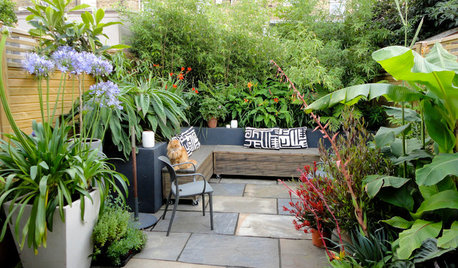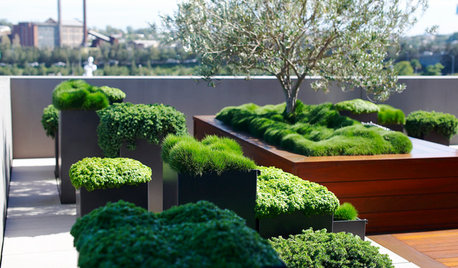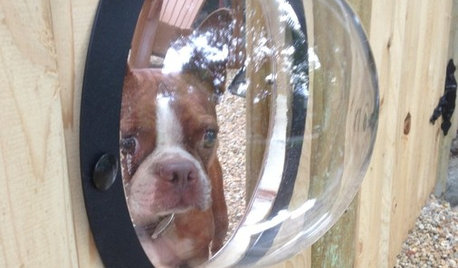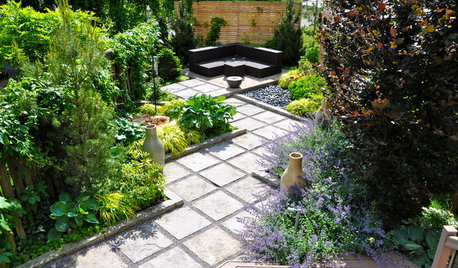another hare-brained soil heating question - OUTDOOR cables??
hairmetal4ever
10 years ago
Related Stories

HEALTHY HOMEGet the Lead Out: Lead Safety at Home
Keep your family safe by properly testing for and dealing with lead in old painted surfaces, water and soil
Full Story
MOST POPULAR10 Reasons to Love a Tiny Garden
Small outdoor spaces can have a beauty all their own
Full Story
LANDSCAPE DESIGNSee How to Turn a Small Outdoor Room Into a Peaceful Retreat
Really, that neglected terrace or courtyard can become the garden of your dreams
Full Story
PETSHouzz Call: Show Us Your Pet Projects!
Bubble windows, fountains, doghouses, showers — what outdoor treats have you put together for your furry friends?
Full Story
MOST POPULARWhat to Know About Adding a Deck
Want to increase your living space outside? Learn the requirements, costs and other considerations for building a deck
Full Story
LANDSCAPE DESIGNHow to Create an Unforgettable Garden
Make an impression that will linger long after visitors have left by looking for the possibilities and meaning in your landscape
Full Story
PETSHow to Help Your Dog Be a Good Neighbor
Good fences certainly help, but be sure to introduce your pup to the neighbors and check in from time to time
Full Story
FALL GARDENING7 Reasons Not to Clean Up Your Fall Garden
Before you pluck and rake, consider wildlife, the health of your plants and your own right to relax
Full Story
CONCRETEWhy Concrete Wants to Crack
We look at the reasons concrete has a tendency to crack — and what you can do to help control it
Full Story
LANDSCAPE DESIGNNatural Swimming Pools: More Beauty, No Chemicals
Keep your skin and the environment healthy with a pool that cleans itself, naturally
Full StoryMore Discussions






pnbrown
ejdiv
Related Professionals
Rancho Palos Verdes Landscape Architects & Landscape Designers · Southfield Landscape Architects & Landscape Designers · Aloha Landscape Contractors · Huntley Landscape Contractors · Lancaster Landscape Contractors · Northport Landscape Contractors · Paramus Landscape Contractors · Pleasanton Landscape Contractors · St. Louis Landscape Contractors · Wells Landscape Contractors · West Orange Landscape Contractors · Hawaiian Gardens Landscape Contractors · Libertyville Driveway Installation & Maintenance · Anaheim Driveway Installation & Maintenance · Parker Driveway Installation & Maintenancethepodpiper
seysonn
mckenziek
thepodpiper
pnbrown
hairmetal4everOriginal Author
pnbrown
wertach zone 7-B SC
seysonn
wertach zone 7-B SC
pnbrown
ejdiv
daninthedirt (USDA 9a, HZ9, CentTX, Sunset z30, Cfa)
ejdiv
daninthedirt (USDA 9a, HZ9, CentTX, Sunset z30, Cfa)
seysonn
daninthedirt (USDA 9a, HZ9, CentTX, Sunset z30, Cfa)
ejdiv
pnbrown
daninthedirt (USDA 9a, HZ9, CentTX, Sunset z30, Cfa)
seysonn
daninthedirt (USDA 9a, HZ9, CentTX, Sunset z30, Cfa)
runswithscissors
daninthedirt (USDA 9a, HZ9, CentTX, Sunset z30, Cfa)
seysonn
daninthedirt (USDA 9a, HZ9, CentTX, Sunset z30, Cfa)
pnbrown
daninthedirt (USDA 9a, HZ9, CentTX, Sunset z30, Cfa)
pnbrown
daninthedirt (USDA 9a, HZ9, CentTX, Sunset z30, Cfa)
mckenziek
pnbrown
daninthedirt (USDA 9a, HZ9, CentTX, Sunset z30, Cfa)
pnbrown
mckenziek
daninthedirt (USDA 9a, HZ9, CentTX, Sunset z30, Cfa)
pnbrown
daninthedirt (USDA 9a, HZ9, CentTX, Sunset z30, Cfa)
northshore3
pnbrown
daninthedirt (USDA 9a, HZ9, CentTX, Sunset z30, Cfa)
mckenziek
daninthedirt (USDA 9a, HZ9, CentTX, Sunset z30, Cfa)
pnbrown
wally_1936
daninthedirt (USDA 9a, HZ9, CentTX, Sunset z30, Cfa)
pnbrown
sjadrnicek